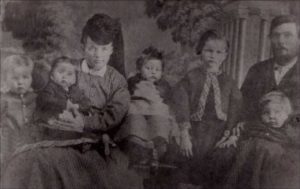John N Ferguson and family (c. 1870)
13 June 2022
Here are John Nimrod Ferguson, his wife Martha Rebecca Weldon, and the first 5 of their 15 (!) children, in about 1870.
Ferguson had enlisted in July 1861 and was elected 2nd Lieutenant of Company C of the 13th Georgia Infantry in September 1862. He was promoted to First Lieutenant on the field and wounded at Sharpsburg on the 17th and survived another wound, at Monocacy in 1864, to return home to Griffin, GA.
In 1870 he took his family to Union Parish, LA and farmed there. In the 1880s he was elected Constable and was murdered while on Parish business in December 1887.
____________
The photograph above was contributed to Martha Rebecca Weldon Ferguson’s memorial on Find-a-grave by Kenneth Pace.
Emma Lent and the rumseller (1886)
13 June 2022
Private James W Lent was about 20 years old when he was wounded at Antietam on 17 September 1862. He continued in service with the 7th Maine and later the First Maine Veteran Infantry to muster-out in June 1865.
I’ve found very little more about him, but this news clip from the Portland Daily Press of 30 March 1886 [online from the Digital Maine Repository] hints at his post-war story:
________
My transcription
Emma J Lent of Manchester [ME], has commenced an action against a rumseller of that town to recover $2000 for selling liquor to her husband.
Pvt Thomas Pearson, Hawkins’ Zouaves (c. 1861)
12 June 2022
This photograph of Thomas Pearson, mortally wounded at Antietam, comes from the amazing collection of Civil War Biographies compiled by volunteers on behalf of the Green-Wood Cemetery in Brooklyn, NY.



